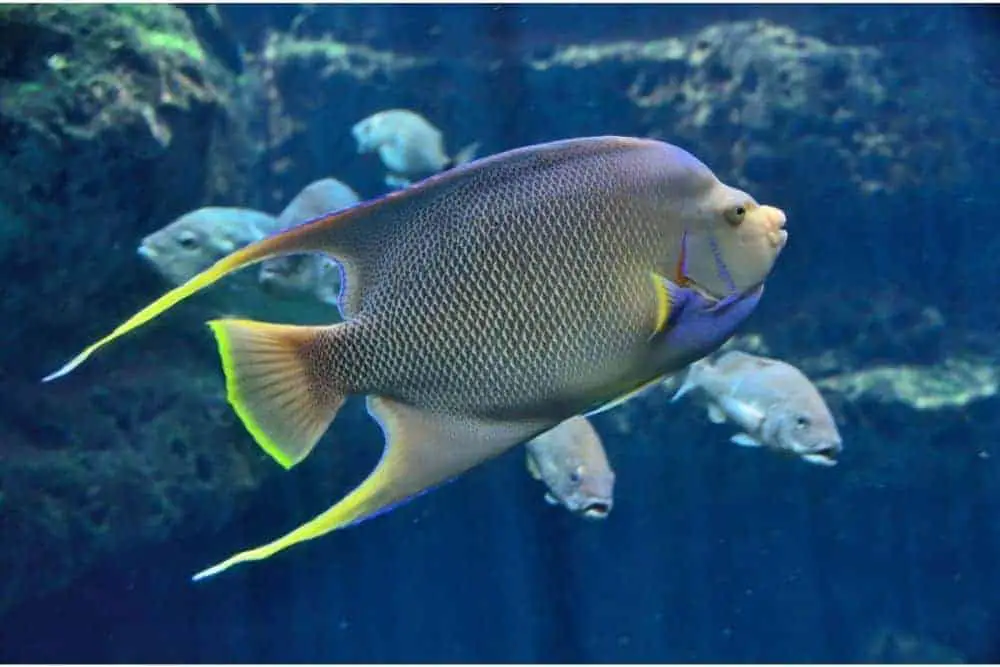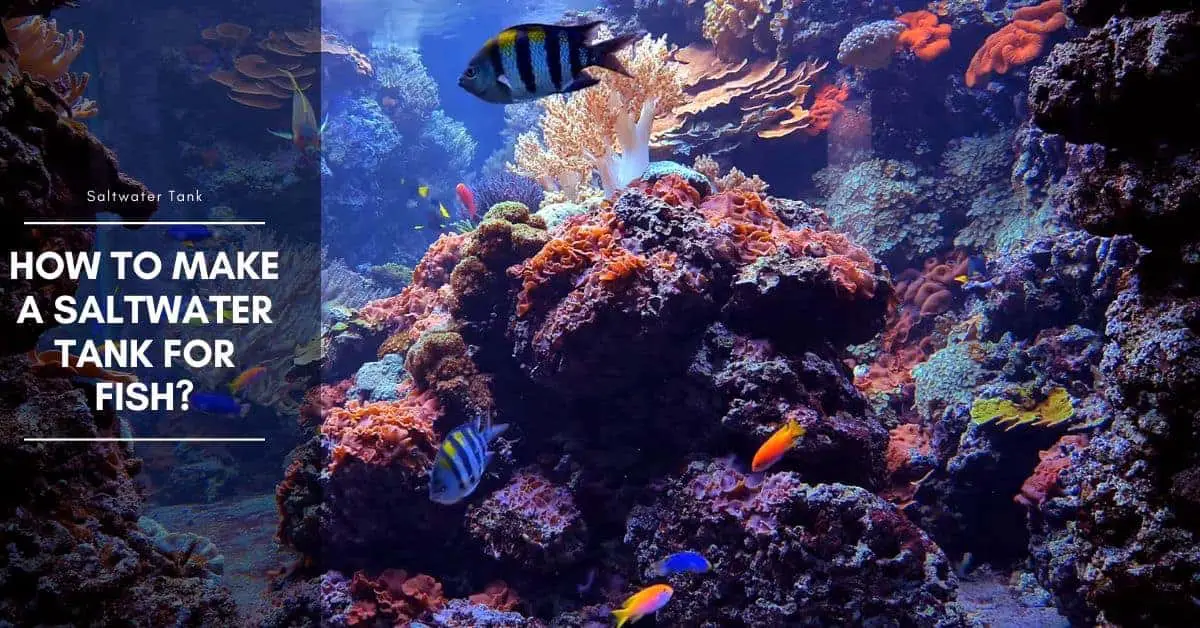Setting up a marine or reef tank is very much like setting up a freshwater tank. We’re going to repeat some of the steps so that you know the exact order to set up your tank. In this way, you won’t need to go back to the first section during the setup.
First, you want to assemble all the components in the area where you plan to place the aquarium. Make sure you have everything. Make sure that you are not lacking any important components. The one thing you don’t want is to be well into setup and find that you are missing something. Once you are confident that everything is in order, take the following steps to set up your aquarium.
Saltwater tank setup checklist
1. How to start?
This is basic and most important! Make sure everything is clean. It can’t be too clean. Give the gravel, tank, filter, heater, aquarium decorations, and anything else you expect to put in the tank a thorough rinsing with clean warm water. Never use commercial cleaners! Some experts use a little salt, but this must be rinsed off with as much water as possible.
Why should you rinse these items if you bought them from your local pet store? Residues, dirt, and other toxic agents can accumulate on your equipment between the time it is manufactured and the time it gets to your home.

Also, you should boil some aquarium decorations, such as coral and shells. Make sure to boil them in freshwater only!
Cleaning your gravel is also very important. Never put unrinsed gravel in your tank. Uncleaned gravel adds dust to the aquarium, making it cloudy. It also makes it unhealthy for your fish. It’s easy to clean gravel. First, empty it into a large container, such as a 5-gallon bucket. Then fill the container with water. Thoroughly stir the water and gravel, making sure you’ve swirled it around as much as possible. Then dump out the water. You’re not done, though. Do this several times, until the water that you pour off is clear. Four to five rinsings are necessary for brand new gravel, and sometimes more.
Avoid all chemicals
Never use any kind of soap when cleaning your aquarium components. This can cause immediate water quality problems and may result in the death of your fish. Remember, fish don’t require a Lysol clean environment. Don’t make this common first-time mistake.
2. Place the saltwater tank on stand
Make sure you place the tank on its stand. You want to make sure the aquarium is exactly where you want it to reside. Do you know how heavy a gallon of water is? You are not moving a 10-, 20-, 30-, or 40gallon tank of water. Once the thing is filled, it is where it’s going to stay. This isn’t a couch. Do not expect to move the tank once it is filled.
API STRESS ZYME Freshwater and Saltwater Aquarium Cleaning Solution 16-Ounce Bottle
API ACCU-CLEAR Freshwater Aquarium Water Clarifier 4-Ounce Bottle
12% OffAPI GENERAL CURE Freshwater and Saltwater Fish Powder Medication 10-Count Box
15% OffNow, you can begin assembling the interior of your tank. It is time to aquascape your tank. Start with the thoroughly rinsed gravel. Place your under-gravel filter first. Gently pour the gravel into the tank. Remember, coarse gravel first. Then the net. Then the finer gravel. Terrace the gravel so that it is slightly higher in the back than in the front of the tank. This adds a natural field depth to your aquarium.
3. Add any larger pieces of coral and rocks
Now for the artsy stuff. This is like laying out the living room of your house. You can play with this for hours. But if you’ve done your homework, you’ll already know what you want and this will go quickly. However, take your time. This should be one of the fun parts of owning an aquarium.
First, add any larger pieces of coral, rock, etc. Don’t attempt to add smaller decorations, yet. If you add the smaller ones now when you pour the water in, they’ll be disturbed by the rushing water, and you’ll have to rearrange everything. The large, immovable things get placed in the tank first. Remember to leave spaces for heaters, filters, and other equipment.
4. Add airstone
This is a great time to add airstones to the aquarium. Make sure to take the opportunity to conceal air supply tubing behind larger decorations. It will be more difficult to do this once the tank is filled.
5. Add water
Now add the water to the tank without disrupting your aquascape. To do this, place a clean plate or bowl on top of the gravel and pour the water onto it. In many cases, tap water will be fine. Check with your local water company if you suspect that your tap water contains chemical impurities, such as nitrates, sulfates, or phosphates, or is chemically treated with chloramine. In some cases, you may need to purchase water or purify the tap water with de-ionizers or nitrate-removing resin. In most cases, the tank-aging process, combined with filtration, will eliminate minor tap water problems.
Keep track of the amount of water you use to fill the tank. Then you can add the artificial salt mix to the aquarium. Read the directions carefully. Follow the manufacturer’s instructions as closely as possible.
6. Add heater, small decorations, thermometer, and lights.
Now is the time to add the heater. Place the heater in the tank near sources of water circulation, such as filter outlets or airstones. This helps to maximize its output. Don’t plug in the heater before you place the heater. Only plug the heater in once the tank has been fully set up. If you plug it in and let it warm up, when you place it in the tank, the glass may crack.
Set up the heater only—not the external power filter. You don’t want to add it yet. You should wait until the water has matured before using chemical and mechanical filtration. Also, do not set up the protein skimmer until the tank has matured and is ready for its inhabitants.
Now you can place the smaller decorations in the tank. You can add the thermometer as well. This is also a great time to fine-tune your aquascape.
Fit the aquarium hood, making sure that the external components and electrical equipment are properly placed. Make sure the hood is not yet plugged in or turned on. Add the light on top of the canopy and make sure that it is correctly hooked up.
7. Turn on the system!
All of you who like to play with sockets can have fun now. When you are confident that the electrical wiring is safely insulated from sources of water, plug the aquarium units in and turn on the system. Make sure the heater is properly adjusted. Don’t be impatient. This may take a day or two. Check the operation of the under-gravel filter, air pumps, and light.
8. Checking the gravity
Now you want to check the gravity. Use your hydrometer to check the specific gravity. The floating hydrometer is the most popular. Use it this way. First, take some aquarium water and pour it into a suitable container. Usually, this is the plastic tube that the hydrometer came in. You want to fill it up high enough to make sure that there is enough water to float the hydrometer. Now, place the hydrometer in the tube.
Make sure that it is floating freely. Read the hydrometer at the waterline. This reading is the specific gravity of the water in your aquarium. Some experts feel that it is important to convert specific gravity to salinity. However, this is not the case. It is not required as long as the temperature in your tank is kept relatively constant. If the specific gravity is not ideal, don’t add freshwater or additional salt. Let it sit for 24 hours. This allows for all the salt to dissolve and reach an equilibrium. After 24 hours, add more salt if the specific gravity is less than 1.024. Or, remove water and add tap water if the salinity is greater than 1.024.
Let the tank sit for a few days
Do nothing! Leave everything alone. Do not turn on the filter. Let the tank sit for a few days. You need to let the tank water mature before you add any fish or coral.

Hi, my name is Sean, and I’m the primary writer on the site. I’m blogging mostly about freshwater and saltwater aquariums, fish, invertebrates, and plants. I’m experienced in the fishkeeping hobby for many years. Over the years I have kept many tanks, and have recently begun getting more serious in wanting to become a professional aquarist. All my knowledge comes from experience and reading forums and a lot of informative sites. In pursuit of becoming a professional, I also want to inspire as many people as I can to pick up this hobby and keep the public interest growing.
Read more about Sean.
Please join also my Facebook group.















